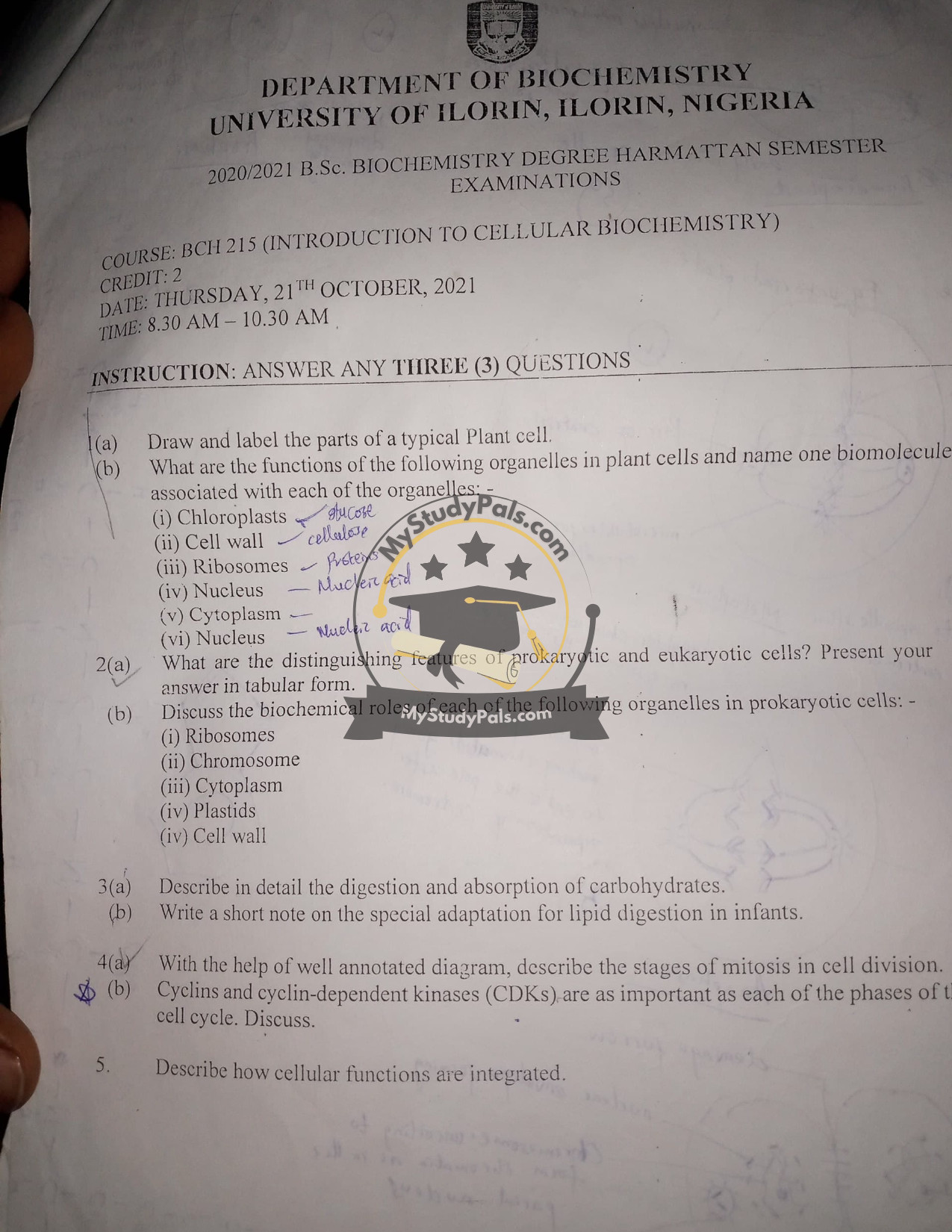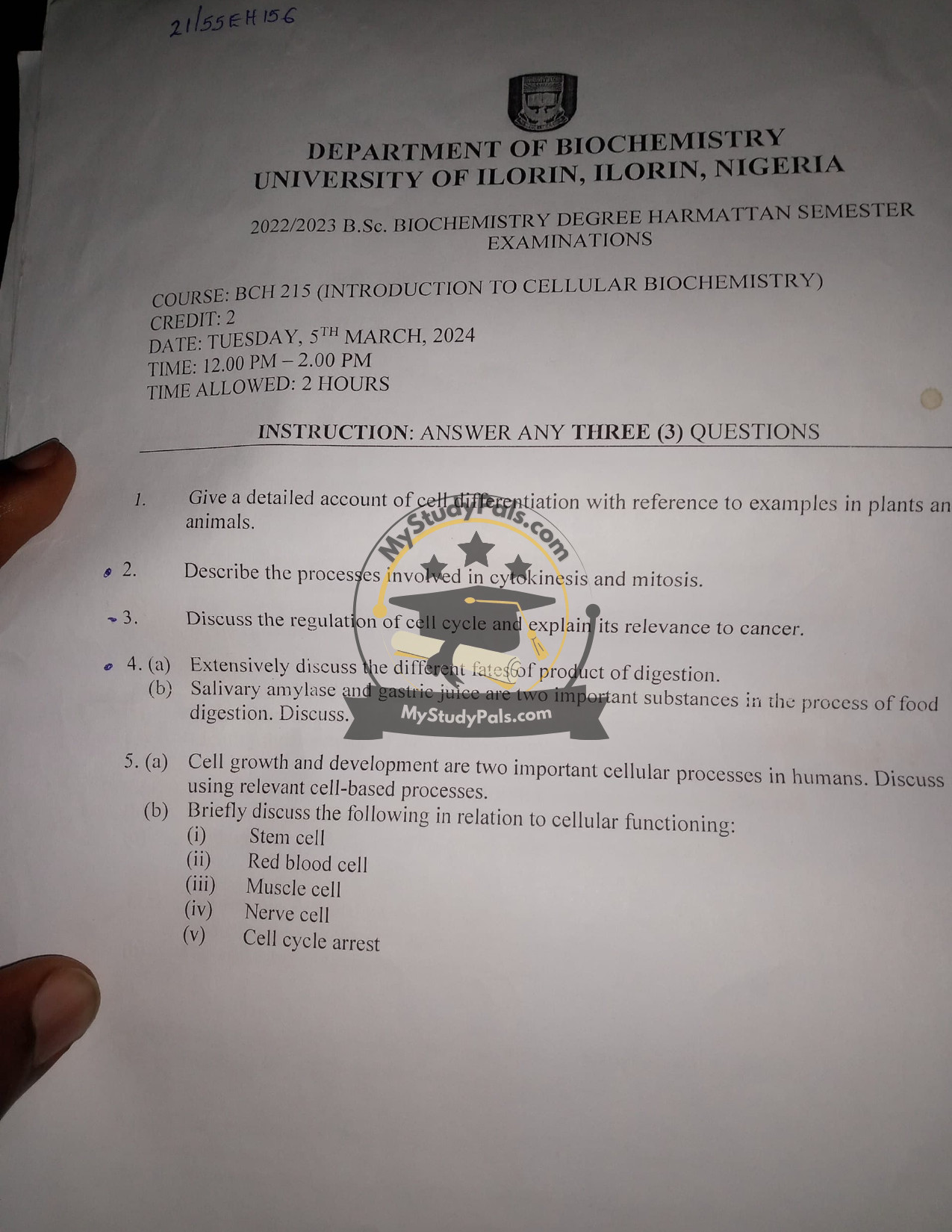ANWSER
Question 1 (2020/2021):
(a) Draw and label the parts of a typical Plant cell.
Answer:
A typical plant cell includes the following labeled parts:
– Cell Wall: Outer rigid layer made of cellulose.
– Cell Membrane: Semi-permeable membrane inside the cell wall.
– Nucleus: Contains genetic material (DNA).
– Chloroplasts: Site of photosynthesis, contains chlorophyll.
– Mitochondria: Powerhouse of the cell, produces ATP.
– Vacuole: Large central vacuole for storage and maintaining turgor pressure.
– Ribosomes: Site of protein synthesis.
– Endoplasmic Reticulum (ER): Rough ER (with ribosomes) and Smooth ER (lipid synthesis).
– Golgi Apparatus: Modifies and packages proteins.
– Cytoplasm: Gel-like substance where organelles are suspended.
(b) Functions of organelles and associated biomolecules:
– (i) Chloroplasts: Function: Photosynthesis. Biomolecule: Glucose.
– (ii) Cell Wall: Function: Provides structural support. Biomolecule: Cellulose.
– (iii) Ribosomes: Function: Protein synthesis. Biomolecule: Protein (e.g., enzymes).
– (iv) Nucleus: Function: Stores genetic material. Biomolecule: Nucleic acids (DNA/RNA).
– (v) Cytoplasm: Function: Site of metabolic reactions. Biomolecule: Nucleic acids (e.g., mRNA).
—
Question 2 (2020/2021):
(a) Distinguishing features of prokaryotic and eukaryotic cells:
Answer:
| Feature | Prokaryotic Cells | Eukaryotic Cells |
|———————–|—————————————|————————————–|
| Nucleus | Absent (nucleoid region) | Present (membrane-bound) |
| Organelles | Absent (no membrane-bound organelles) | Present (e.g., mitochondria, Golgi) |
| Cell Size | Smaller (1-10 μm) | Larger (10-100 μm) |
| DNA Structure | Circular DNA | Linear DNA (chromosomes) |
| Cell Division | Binary fission | Mitosis/Meiosis |
(b) Biochemical roles of prokaryotic organelles:
– (i) Ribosomes: Protein synthesis (70S type).
– (ii) Chromosome: Stores genetic material (circular DNA).
– (iii) Cytoplasm: Contains enzymes for metabolic pathways (e.g., glycolysis).
– (iv) Plastids: Absent in most prokaryotes (except cyanobacteria with thylakoids for photosynthesis).
– (v) Cell Wall: Provides shape and protection (made of peptidoglycan).
—
Question 3 (2020/2021):
(a) Digestion and absorption of carbohydrates:
Answer:
– Mouth: Salivary amylase breaks starch into maltose.
– Stomach: Amylase inactivated by acidic pH.
– Small Intestine: Pancreatic amylase converts starch to disaccharides (maltose, lactose, sucrose). Brush border enzymes (maltase, lactase, sucrase) hydrolyze disaccharides into monosaccharides (glucose, fructose, galactose).
– Absorption: Monosaccharides are absorbed via active transport (glucose/galactose) or facilitated diffusion (fructose) into bloodstream.
(b) Special adaptation for lipid digestion in infants:
– Infants produce lingual lipase (activated in stomach) to digest milk fats.
– Breast milk contains bile salt-stimulated lipase (BSSL) to aid lipid digestion in immature pancreatic function.
—
Question 4 (2020/2021):
(a) Stages of mitosis:
Answer:
1. Prophase: Chromatin condenses into chromosomes; nuclear envelope breaks down.
2. Metaphase: Chromosomes align at metaphase plate.
3. Anaphase: Sister chromatids separate and move to opposite poles.
4. Telophase: Nuclear envelopes reform; chromosomes decondense.
5. Cytokinesis: Cytoplasm divides (animal cells: cleavage furrow; plant cells: cell plate).
(b) Role of cyclins and CDKs:
– Cyclins bind to CDKs to activate them, regulating cell cycle phases (e.g., G1/S, G2/M checkpoints).
– Example: Cyclin B-CDK1 complex triggers mitosis. Dysregulation can lead to uncontrolled cell division (cancer).
—
Question 5 (2020/2021):
Describe how cellular functions are integrated.
Answer:
– Signaling Pathways: Hormones/ligands bind receptors, triggering cascades (e.g., cAMP, MAPK).
– Organelle Coordination: ER synthesizes proteins; Golgi modifies them; mitochondria provide ATP.
– Gene Regulation: Transcription factors adjust protein synthesis based on cellular needs.
– Feedback Mechanisms: Negative feedback (e.g., ATP inhibiting glycolysis) maintains homeostasis.
—
Question 1 (2022/2023):
Cell differentiation in plants and animals:
Answer:
– Animals: Stem cells differentiate into specialized cells (e.g., hematopoietic stem cells → RBCs).
– Plants: Meristematic cells differentiate into roots, leaves, or flowers (e.g., auxin-induced root growth).
– Biochemical Basis: Differential gene expression and signaling molecules (e.g., morphogens).
—
Question 2 (2022/2023):
Cytokinesis and mitosis:
Answer:
– Mitosis: As described above (nuclear division).
– Cytokinesis:
– Animals: Actin-myosin ring forms cleavage furrow.
– Plants: Vesicles form cell plate at metaphase plate, developing into new cell wall.
—
Question 3 (2022/2023):
Regulation of cell cycle and cancer:
Answer:
– Checkpoints: G1 (DNA integrity), S (DNA replication), G2 (damage repair), M (chromosome attachment).
– Cancer Link: Mutations in cyclins, CDKs, or tumor suppressors (e.g., p53) bypass checkpoints, causing uncontrolled proliferation.
—
Question 4 (2022/2023):
(a) Fates of digestion products:
– Glucose: Energy (glycolysis) or stored as glycogen.
– Amino Acids: Protein synthesis or gluconeogenesis.
– Fatty Acids: Energy (β-oxidation) or stored as triglycerides.
(b) Salivary amylase and gastric juice:
– Salivary Amylase: Breaks starch into maltose (pH 6.7-7.0).
– Gastric Juice: HCl denatures proteins (activates pepsin); no carbohydrate digestion.
—
Question 5 (2022/2023):
(a) Cell growth and development:
– Growth: Increase in size (e.g., hypertrophy, hyperplasia).
– Development: Differentiation (e.g., myoblasts → muscle fibers).
(b) Cellular functioning:
– (i) Stem Cell: Undifferentiated; can self-renew or differentiate.
– (ii) RBC: Transports O2/CO2; lacks nucleus.
– (iii) Muscle Cell: Contracts (actin/myosin).
– (iv) Nerve Cell: Transmits signals (axons/dendrites).
– (v) Cell Cycle Arrest: Halts cycle due to damage (e.g., p53 activation).



